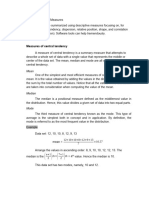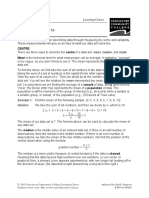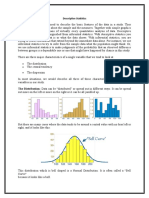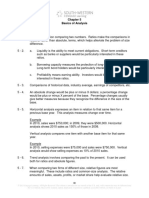Q1 Ans
Q1 Ans
Uploaded by
SHAMRAIZKHANCopyright:
Available Formats
Q1 Ans
Q1 Ans
Uploaded by
SHAMRAIZKHANOriginal Title
Copyright
Available Formats
Share this document
Did you find this document useful?
Is this content inappropriate?
Copyright:
Available Formats
Q1 Ans
Q1 Ans
Uploaded by
SHAMRAIZKHANCopyright:
Available Formats
Q1 ans(A) : Mean: Mean is the arithmetic average and it is probably the measure
of central tendency that you are most familiar.
Calculating the mean is very simple. You just add up all of the values and divide by the number
0f observations in your dataset.
= x1+x2+….+xn/n
However, in a skewed distribution the mean can miss the mark. in histogram it is starting to fall
outsode the central area. Problem occurs because outliers have a substantial impact on the mean.
Extreme values in an extended tail pull the mean away from the centre. As the distribution
becomes more skewed, the mean is drawn further away from the centre.
Median: median is the middle value. It is the value splits the dataset in half. To find the
median, order your data from smallest to largest and then find the data point that has an equal
amount of values above it and below it. The method for locating the median varies slightly
depending on whether your dataset has an even or odd number of values.
In the example, I use whole numbers for simplicity but you can have decimal places. In the
dataset with the odd number of observation notice how the number 12 has six values above it and
six below it. Therefore, 12 is the median of this dataset.
Mode: mode is the value that occurs the most frequently in your dataset. On a bar chart, the
mode is the highest bar. If the data have multiples value that are tied for occurring the most
frequently, you have a multimodal distribution. If no value repeats, the data do not have a mode.
(B) Ans: variance: variance in statistics is a measurement of the spread between
numbers in a dataset. That is, it measures how far each each number in the set is from yhe mean
and therefore from every other number in the set.
Understanding the variance is calculated by taking the differences between each number in the
datset and the mean then squaring the differences to make thewm positive and finally dividing
the sum of squares by the number of value in the dataset.
Variance= (xi-x)2/n
Suppose the scores are 67,72,85, 93, 98.
Variance = (x-|x|)/n
|x|=83,n=5
Total variance is 141.2.
(C) Ans: Complementary Cumulative Distribution Function(CCDF): CDf describes the
probability that a random variable X with a given probability distribution will be found at a
value less than or equal to x.
You might also like
- Basic Statistics AssignmentDocument5 pagesBasic Statistics Assignmentsantosh raazNo ratings yet
- Biostatistics For Academic2Document38 pagesBiostatistics For Academic2Semo gh28No ratings yet
- MMW Managing DataDocument3 pagesMMW Managing Datashalala16763118No ratings yet
- What Do We Do With Data?Document16 pagesWhat Do We Do With Data?Kiran KishoreNo ratings yet
- Quantitative Techniques in Business: Statistical PartDocument28 pagesQuantitative Techniques in Business: Statistical PartMuhammad ArslanNo ratings yet
- Unit 3Document13 pagesUnit 3Uttareshwar SontakkeNo ratings yet
- Biostatistics Unit 3 Measures of Statistics - Central TendencyDocument57 pagesBiostatistics Unit 3 Measures of Statistics - Central Tendencylinetmuthoniw4No ratings yet
- Unit-3 DS StudentsDocument35 pagesUnit-3 DS StudentsHarpreet Singh BaggaNo ratings yet
- Measure of Variability Ungrouped DataDocument22 pagesMeasure of Variability Ungrouped DataSUNSHINE M. DELA CRUZNo ratings yet
- Measures of central tendency and dispersionDocument9 pagesMeasures of central tendency and dispersionAlduin04No ratings yet
- ASSIGNMEN4Document15 pagesASSIGNMEN4Harshita Sharma100% (1)
- Measure of Central Tendency in StatisticsDocument16 pagesMeasure of Central Tendency in StatisticsAnshu SinghNo ratings yet
- Statistical Machine LearningDocument12 pagesStatistical Machine LearningDeva Hema100% (1)
- Q No#1: Tabulation: 5 Major Objectives of Tabulation: (1) To Simplify The Complex DataDocument13 pagesQ No#1: Tabulation: 5 Major Objectives of Tabulation: (1) To Simplify The Complex Datasami ullahNo ratings yet
- Q No#1: Tabulation: 5 Major Objectives of Tabulation: (1) To Simplify The Complex DataDocument13 pagesQ No#1: Tabulation: 5 Major Objectives of Tabulation: (1) To Simplify The Complex Datasami ullah100% (1)
- Normal DistributionsDocument11 pagesNormal DistributionsWaseem Javaid SoomroNo ratings yet
- MeanDocument4 pagesMeanSteward john Dela cruzNo ratings yet
- Describing Data: Centre Mean Is The Technical Term For What Most People Call An Average. in Statistics, "Average"Document4 pagesDescribing Data: Centre Mean Is The Technical Term For What Most People Call An Average. in Statistics, "Average"Shane LambertNo ratings yet
- Bio Statistics 3Document13 pagesBio Statistics 3Moos LightNo ratings yet
- Unit 1 - Business Statistics & AnalyticsDocument25 pagesUnit 1 - Business Statistics & Analyticsk89794No ratings yet
- Measures of Central TendencyDocument42 pagesMeasures of Central Tendencyalwayssmile5807No ratings yet
- Edu 533 OutlineDocument10 pagesEdu 533 OutlineTeresa B. TimonNo ratings yet
- Project 1 - Descriptive StatisticsDocument11 pagesProject 1 - Descriptive StatisticsAna ChikovaniNo ratings yet
- Mean Median ModeDocument10 pagesMean Median ModeEprinthousespNo ratings yet
- Descriptive Statistics MBADocument7 pagesDescriptive Statistics MBAKritika Jaiswal100% (2)
- Stt511 Lecture02Document27 pagesStt511 Lecture02ragingbeast76No ratings yet
- Stats 3Document12 pagesStats 3Marianne Christie RagayNo ratings yet
- Meharaj Khan (BS)Document7 pagesMeharaj Khan (BS)RebelNo ratings yet
- Statistics TheoreticalDocument17 pagesStatistics TheoreticalMustafa BrifkaniNo ratings yet
- M6u6 Parent Letter 2017Document2 pagesM6u6 Parent Letter 2017api-366803594No ratings yet
- Nummerical SummariesDocument11 pagesNummerical Summaries60 Vibha Shree.SNo ratings yet
- Lecture 3 - Data Summarization Measure of Central Tendency Spread.V1Document48 pagesLecture 3 - Data Summarization Measure of Central Tendency Spread.V1YeshaelNo ratings yet
- Stats Week 1 PDFDocument6 pagesStats Week 1 PDFAnonymous n0S2m9sR1ENo ratings yet
- Mathematical AnalysisDocument46 pagesMathematical AnalysisGilbert Dwasi100% (1)
- Notas EstadisticaDocument20 pagesNotas EstadisticaCristian CanazaNo ratings yet
- 3 Chap III CT Q FDocument40 pages3 Chap III CT Q Fexams_sbsNo ratings yet
- Descriptive StatDocument13 pagesDescriptive StatJoshrel CieloNo ratings yet
- Descriptive Statistics: Mean or AverageDocument5 pagesDescriptive Statistics: Mean or AverageNeelNo ratings yet
- Stat 104 Section 3.1docx(1)Document3 pagesStat 104 Section 3.1docx(1)timmielcarek677No ratings yet
- Glossary of TermsDocument7 pagesGlossary of TermsKathzkaMaeAgcaoiliNo ratings yet
- Measures of Central Tendency: Mean, Mode, Median: Soumendra RoyDocument34 pagesMeasures of Central Tendency: Mean, Mode, Median: Soumendra Roybapparoy100% (1)
- Q4 LAS 4 Measures of VariabilityDocument34 pagesQ4 LAS 4 Measures of VariabilityErnesto S. Caseres JrNo ratings yet
- Dsbda Unit 2Document155 pagesDsbda Unit 2king makerNo ratings yet
- Data Notes For IN3Document66 pagesData Notes For IN3Lyse NdifoNo ratings yet
- Calculating Standard Error Bars For A GraphDocument6 pagesCalculating Standard Error Bars For A GraphKona MenyongaNo ratings yet
- Statistics Mean, Median, ModeDocument36 pagesStatistics Mean, Median, Moderoshni100% (1)
- Statistics Is The Study of The Collection, Organization, Analysis, Interpretation, andDocument18 pagesStatistics Is The Study of The Collection, Organization, Analysis, Interpretation, andLyn EscanoNo ratings yet
- Descriptive StatisticsDocument4 pagesDescriptive StatisticsRaghad Al QweeflNo ratings yet
- StatisticsDocument30 pagesStatisticsGolaotsemang LebeseNo ratings yet
- Statical Data 1Document32 pagesStatical Data 1Irma Estela Marie EstebanNo ratings yet
- Chapt3 OverheadsDocument8 pagesChapt3 OverheadsGouri DasNo ratings yet
- Measures of Central TendencyDocument8 pagesMeasures of Central TendencyAnnie Claire VisoriaNo ratings yet
- Business Analytics AssignmentDocument5 pagesBusiness Analytics AssignmentRichard NarcisoNo ratings yet
- Module 3Document11 pagesModule 3Sayan MajumderNo ratings yet
- The MedianDocument4 pagesThe Medianapi-140032165No ratings yet
- DSBDL Asg 3 Write UpDocument6 pagesDSBDL Asg 3 Write UpsdaradeytNo ratings yet
- VariabilityDocument8 pagesVariabilityJelica VasquezNo ratings yet
- Statistics Part 1 and 2Document53 pagesStatistics Part 1 and 2ledwabakarabo23No ratings yet
- Statistical AnalysisDocument15 pagesStatistical AnalysisHello HelloNo ratings yet
- Project Cost Management-1Document17 pagesProject Cost Management-1SHAMRAIZKHANNo ratings yet
- Income Statement: The Star Logo, and South-Western Are Trademarks Used Herein Under LicenseDocument24 pagesIncome Statement: The Star Logo, and South-Western Are Trademarks Used Herein Under LicenseSHAMRAIZKHANNo ratings yet
- Behavioural Economics (Spring 2020) Lecture I - IntroductionDocument34 pagesBehavioural Economics (Spring 2020) Lecture I - IntroductionSHAMRAIZKHANNo ratings yet
- 2nd Sessional CHN - BBADocument2 pages2nd Sessional CHN - BBASHAMRAIZKHANNo ratings yet
- Behavioural Economics (Spring 2020) : Andrea Giovannetti Office Hour: Fri (10:30-11:30) Zoom: 8712136666Document43 pagesBehavioural Economics (Spring 2020) : Andrea Giovannetti Office Hour: Fri (10:30-11:30) Zoom: 8712136666SHAMRAIZKHANNo ratings yet
- Behavioural Economics (Spring 2020) : Prospect Theory and Applications Reference-Point Determination TutorialDocument58 pagesBehavioural Economics (Spring 2020) : Prospect Theory and Applications Reference-Point Determination TutorialSHAMRAIZKHANNo ratings yet
- Behavioural Economics (Spring 2020) : Survey Limit of EUT & Prospect Theory I Tutorial On EV and EUTDocument68 pagesBehavioural Economics (Spring 2020) : Survey Limit of EUT & Prospect Theory I Tutorial On EV and EUTSHAMRAIZKHANNo ratings yet
- Behavioural Economics (Spring 2020) : HD and Commitment HD in The Field TutorialDocument46 pagesBehavioural Economics (Spring 2020) : HD and Commitment HD in The Field TutorialSHAMRAIZKHANNo ratings yet
- BUS101 Final Exam Summer - FTHE - 2020 (Ver B) - QuestionsDocument16 pagesBUS101 Final Exam Summer - FTHE - 2020 (Ver B) - QuestionsSHAMRAIZKHAN0% (1)
- BUS101 Final Exam Summer - FTHE - 2020 (Ver B) - QuestionsDocument16 pagesBUS101 Final Exam Summer - FTHE - 2020 (Ver B) - QuestionsSHAMRAIZKHAN0% (1)
- Gibson Ch05 SM 13eDocument19 pagesGibson Ch05 SM 13eSHAMRAIZKHANNo ratings yet
- Gibson10e ch02Document23 pagesGibson10e ch02SHAMRAIZKHANNo ratings yet
- CH 03: Products and Services: ProductDocument1 pageCH 03: Products and Services: ProductSHAMRAIZKHANNo ratings yet
- A Strategic Analysis of A Company in The Wedding IndustryDocument86 pagesA Strategic Analysis of A Company in The Wedding IndustrySHAMRAIZKHANNo ratings yet
- Name: Shamraiz Khan Reg No: FA17-BBA-042 Assignment: 1 Date: 04-03-2020Document4 pagesName: Shamraiz Khan Reg No: FA17-BBA-042 Assignment: 1 Date: 04-03-2020SHAMRAIZKHANNo ratings yet
- Chapter No.: 6 Financial Plans: 6.1 Financial Projections: Items Amount in PKRDocument2 pagesChapter No.: 6 Financial Plans: 6.1 Financial Projections: Items Amount in PKRSHAMRAIZKHANNo ratings yet
- Chapter 02: Company SummaryDocument4 pagesChapter 02: Company SummarySHAMRAIZKHANNo ratings yet
- Write Approved Name of Business Plan Here (Business Plan) : Project Report OnDocument6 pagesWrite Approved Name of Business Plan Here (Business Plan) : Project Report OnSHAMRAIZKHANNo ratings yet
- Investment BanksDocument8 pagesInvestment BanksSHAMRAIZKHANNo ratings yet
- Chinese (HUM434) Unit 1 Lesson 08 Unit 1 Lesson 08Document6 pagesChinese (HUM434) Unit 1 Lesson 08 Unit 1 Lesson 08SHAMRAIZKHANNo ratings yet
- Lecturer 17: Buy Side AnalystsDocument8 pagesLecturer 17: Buy Side AnalystsSHAMRAIZKHANNo ratings yet
- CH 01Document47 pagesCH 01SHAMRAIZKHANNo ratings yet
- Chinese (HUM434) Unit 1 Lesson 07 Unit 1 Lesson 07Document10 pagesChinese (HUM434) Unit 1 Lesson 07 Unit 1 Lesson 07SHAMRAIZKHANNo ratings yet
- CHN Unit 01 Lesson 04Document7 pagesCHN Unit 01 Lesson 04SHAMRAIZKHANNo ratings yet
- CH 02Document61 pagesCH 02SHAMRAIZKHAN100% (2)
- Internal and External AuditorsDocument19 pagesInternal and External AuditorsSHAMRAIZKHANNo ratings yet
- Week 11, Lecture 1 &2Document20 pagesWeek 11, Lecture 1 &2SHAMRAIZKHANNo ratings yet
- Training and Developing EmployeesDocument25 pagesTraining and Developing EmployeesSHAMRAIZKHANNo ratings yet
- Corporate GovernanceDocument6 pagesCorporate GovernanceSHAMRAIZKHANNo ratings yet
- Earnings Management Earnings ManagementDocument10 pagesEarnings Management Earnings ManagementSHAMRAIZKHANNo ratings yet
























































































